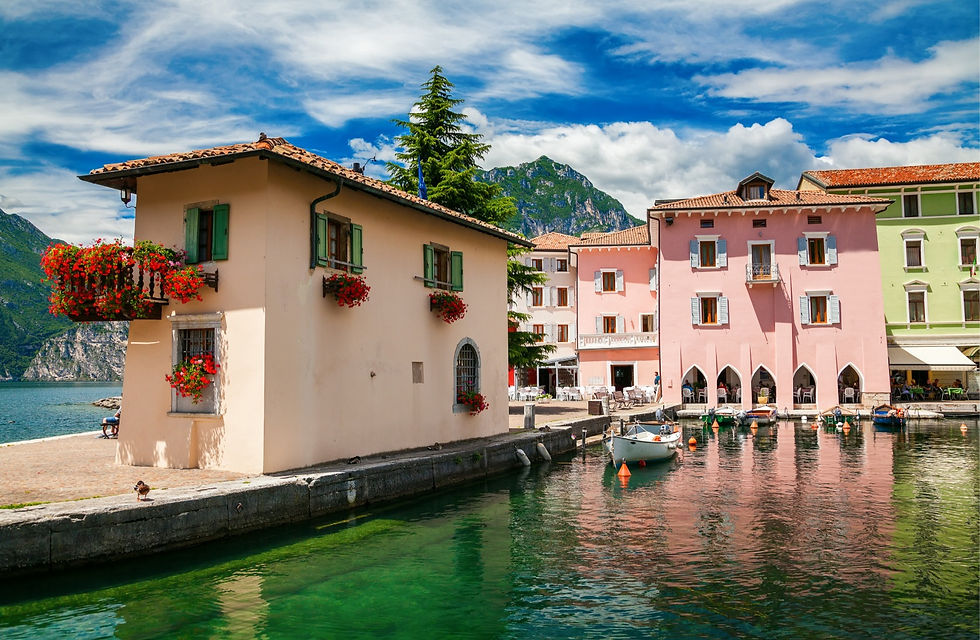Torbole, a small town jewel
- eleonora379
- Apr 15, 2023
- 3 min read
5 things you absolutely must not miss during your holidays in Torbole:
1) THE CHURCH OF SANT'ANDREA

The main church of Torbole is dedicated to Saint Andrew Apostle and its construction dates back to the XIII century.
The church has a Romanesque-Gothic architectural style, with a gabled facade in exposed stone and a bell tower on the right. The interior of the church consists of a single nave with a cross vault, and features frescoes and paintings dating back to the 15th century.
The view of the lake and part of the historic center of Torbole is a small marvel, a place much loved by the people of Torbole both for its beauty and for its historical importance.
2) THE BUSATTE PARK

Parco delle Busatte seems to be an ideal place for those who seek an escape from the frenetic life of the city and want to enjoy the natural beauty of the Monte Baldo mountains and Lake Garda. With its dominant position and proximity to the lake, the park offers a spectacular view of the surrounding area, away from traffic, immersed in a peaceful and quiet environment, ideal for relaxing and regenerating.
Inside the park you will also find a beautiful Adventure Park, where you can have a very fun and adventurous experience.
Acrobatic courses divided by difficulty and age, zip lines, lianas, nets, Nepalese bridges, balancing games, all in total safety!
More information:
3) THE BUSATTE - TEMPESTA TRAIL

The Busatte Tempesta trail is a hiking trail that winds along the rock faces of Monte Baldo above Lake Garda in Italy. It is about 2.5 km long and offers a breathtaking panoramic view of the lake and the surrounding mountains.
The path is well signposted and equipped with walkways, suspended bridges and steps, but requires good physical preparation and a certain ability to walk in a mountain environment. The route is divided into three sections, each with increasing difficulty.
The first part is relatively easy, with a flat route and a few flights of stairs. The second part becomes more challenging, with steeper sections and some suspended walkways. The third part is the most difficult, with an exposed and steep section that requires the use of fixed ropes to help you climb.
The Busatte Tempesta path is one of the most spectacular excursions on Lake Garda and offers an unforgettable experience for nature and adventure lovers. It is advisable to tackle the route with trekking shoes and adequate equipment, always following the instructions and precautions necessary to ensure your safety.
4) THE MARMITTE DEI GIGANTI

The Marmitte dei Giganti are large rock formations created by the erosive action of the glacier which, over the course of millennia, has dug deep conical-shaped cavities in the rock, with diameters ranging from a few centimeters to several metres.
The name "Marmitte dei Giganti" derives from the legend according to which these holes were created by the giants who lived in the surrounding mountains, who used these cavities as pots to cook their meals.
In reality, these wells were already inhabited millennia ago, as evidenced by the discovery of arrowheads and ceramic fragments dating back to the 4th and 3rd millennium BC. This suggests that the area was inhabited by human populations in prehistoric times.

Nowadays, the Marmitte dei Giganti are a very popular tourist destination for their natural beauty and for the possibilities for excursions and sporting activities they offer.
Furthermore, they also represent an important geological site, which makes it possible to study the evolution of the territory over the millennia.
5) THE OLD AUSTRIAN CUSTOM HOUSE, also known as CASA DEL DAZIO

Few know that until 3 November 1918, the year in which Trento, Trieste and all the territories south of the Brenner were annexed to Italy, Torbole was actually part of the Austro-Hungarian Empire.
The small Venetian-style house that dominates the wonderful little port of the town is one of the most vivid memories we have of our recent past.
That house was in fact the old Austrian customs house, also known as Casa del Dazio.
The building was built at the end of the 18th century and was part of the Austrian customs system which controlled commercial traffic along the Brenner road.
After the First World War, the Old Austrian Customs was abandoned and was later acquired by a private individual.
The Old Austrian Customs House has become a symbol of tourism in the area and is often used as a backdrop for photos and postcards, especially on winter evenings when one is enchanted by the wonderful sunsets that our lake gives us.



Comments